Las soluciones de Saint-Gobain Isover y Saint-Gobain Placo, fabricantes líderes en el mercado de aislamiento y placa de yeso laminado, están presentes en el nuevo Aulario de la Universidad Europea Miguel Cervantes.
La Universidad Europea Miguel de Cervantes (UEMC) ubicada en Valladolid, Castilla y León, ha dado un paso significativo hacia la modernización y expansión de su campus con la construcción de un nuevo aulario. Este proyecto, liderado y diseñado por el prestigioso estudio de arquitectos Paredes y Rivas, destaca no solo por su diseño innovador, sino también por su compromiso con la sostenibilidad y el bienestar de los estudiantes.
En los últimos años, la UEMC ha experimentado un notable crecimiento, superando los 2.000 estudiantes presenciales y más de 5.300 en total. Por ello, este nuevo aulario responde a la gran necesidad de ampliar las instalaciones para acoger nuevas titulaciones y reforzar su oferta académica.
Se trata de un campus en constante evolución que, desde su fundación en 2002, ha apostado por un modelo educativo innovador y personalizado. Con esta ampliación se ha logrado mejorar la infraestructura y reafirmar el compromiso de la universidad con una educación de calidad, sostenible y adaptada a los retos del siglo XXI.
La instalación del aislamiento, las divisiones interiores y el acondicionamiento de los espacios ha sido llevado a cabo por la empresa instaladora ARTECO, con el objetivo de que cada detalle del proyecto cumpliese con los más altos estándares de calidad y eficiencia. Además, el diseño arquitectónico contempla una urbanización interior que ha optimizado la movilidad y la entrada de luz natural, contribuyendo así al bienestar de los estudiantes y del personal docente.
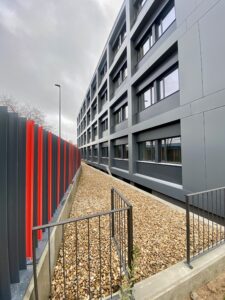
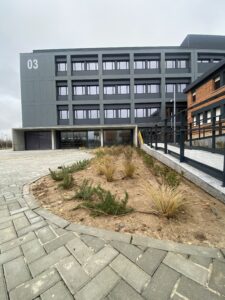
SOLUCIONES EFICIENTES Y SOSTENIBLES SAINT-GOBAIN
Uno de los elementos más destacados del proyecto es la incorporación de las placas de yeso laminado Placo® PPH en tabiquería, que ha contribuido a mejorar el aislamiento acústico de los espacios. En esta misma línea y con el objetivo de disminuir los tiempos de reverberacion de las aulas, los techos han sido ejecutados con Gyptone® Activ’Air®, una placa perforada mediante punzonado especialmente diseñada para corregir la acústica de los espacios.
Otro de los objetivos de este proyecto era el de hacer de este nuevo aulario un espacio salubre para alumnos y profesores. Gracias a la tecnología Activ’Air® incorporada en la placa para techos se ha conseguido mejorar la calidad del aire interior, lo que supone un enorme beneficio para los ocupantes de este edificio. Esta tecnología, exclusiva de Placo®, capta los formaldehidos del ambiente y los transforma en sustancias inertes no contaminantes, consiguiendo mejorar la calidad del aire en un 70%.
En exteriores, la fachada de este edificio incorpora las lanas minerales Geowall 37 en el sistema Ecosec y arena APTA en trasdosados, ambos de Saint-Gobain Isover, proporcionando a los muros un excelente nivel de aislamiento térmico y acústico. La lana mineral arena APTA (Altas Prestaciones Térmicas y Acústicas) es un material no hidrófilo, incombustible y 100% reciclable que ha contribuido a disminuir las pérdidas energéticas de la envolvente del nuevo aulario, reduciendo así la huella de carbono del edificio. Sus aulas combinan diseño, funcionalidad y sostenibilidad, mejorando la infraestructura del campus y creando un entorno más saludable y adecuado para las personas y el planeta.
Además, como solución para climatización la obra también cuenta con CLIMAVER ® Neto, un panel rígido de lana de vidrio Isover para garantizar un correcto aislamiento térmico y acústico en las instalaciones. Esta solución es un conducto autoportante de lana mineral que cuenta con la mejor clasificación de estanqueidad del aire ATC 1, reduciendo hasta en un 97% las fugas de aire según RITE.
Las soluciones de Saint-Gobain instaladas en este proyecto responden al compromiso de sus marcas de construir mejor para las personas y el planeta, siempre guiadas por el propósito común del Grupo Saint-Gobain “MAKING THE WORLD A BETTER HOME”.
Sobre Saint-Gobain
Líder mundial en construcción ligera y sostenible, Saint-Gobain diseña, fabrica y distribuye materiales y servicios para los mercados de la construcción y la industria. Sus soluciones, integradas para la renovación de edificios públicos y privados, la construcción ligera y la descarbonización de la construcción y la industria, se desarrollan a través de un proceso continuo de innovación, proporcionan sostenibilidad y grandes prestaciones. El Grupo, que celebra su 360 aniversario en 2025, está más comprometido que nunca con su propósito de “MAKING THE WORLD A BETTER HOME”.
En el sector de la edificación, nos comprometemos a construir mejor para las personas y el planeta, a través de las marcas Saint-Gobain Glass, Isover, Placo® y Weber, ofreciendo la más amplia gama de sistemas innovadores que proporcionan confort, eficiencia energética, rendimiento y seguridad para impulsar la transformación del mercado de la construcción.
Saint-Gobain Isover, líder en soluciones de aislamiento térmico, acústico y protección frente al fuego para edificación y aplicaciones técnicas. Cuenta con líneas de producción de lana de roca y lana de vidrio proporcionando la gama más amplia de sistemas para cinco mercados distintos: edificación, industria, marina, HVAC (soluciones para climatización y ventilación) y OEMs,
Saint-Gobain Placo, fabricante líder en el sector de la placa de yeso laminado y soluciones en base yeso, que contribuyen a optimizar la eficiencia energética de los edificios, con las más altas prestaciones. Ofrece la más amplia gama de sistemas innovadoras para tabiques, particiones, techos y fachadas, para el acondicionamiento y la construcción de edificios tanto de obra nueva, como para rehabilitación.
La silicona que sella las juntas de la encimera de la cocina protege contra el agua y la humedad. Con el paso del tiempo, esta silicona tiende a deteriorarse y ennegrecerse debido a la proliferación de moho y acumulación de suciedad. Las juntas presentan una apariencia sucia y dan sensación de falta de higiene, aunque la cocina está limpia.
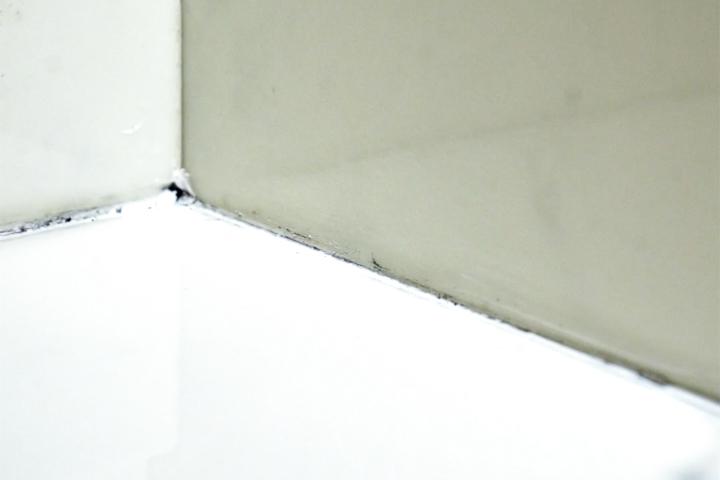
El moho es un hongo microscópico que libera esporas e incluso penetra en los poros de la silicona haciendo que esta se endurezca, tenga mal olor, pierda elasticidad y termine agrietándose.
Las grietas pueden incluso generar filtraciones de agua, acelerando el proceso de degradación del material y llegando a dañar la encimera o el mueble de cocina.
Entre las causas más comunes de deterioro de la silicona en una encimera destacan:
Para eliminar la silicona deteriorada, en FILA contamos con la solución ZEROSIL, un quitasiliconas profesional que reblandece el sellante sin dañar la superficie.
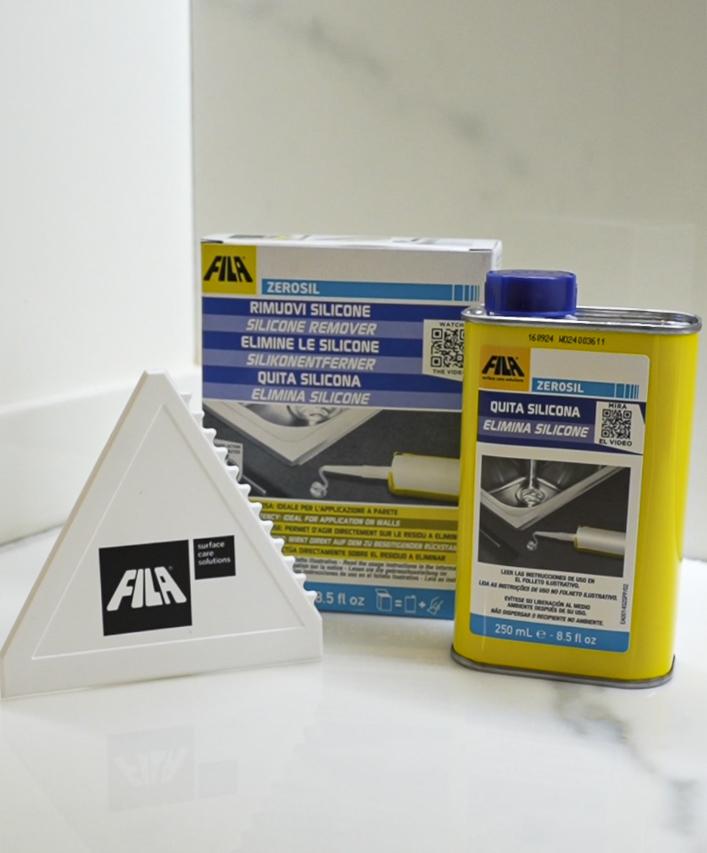
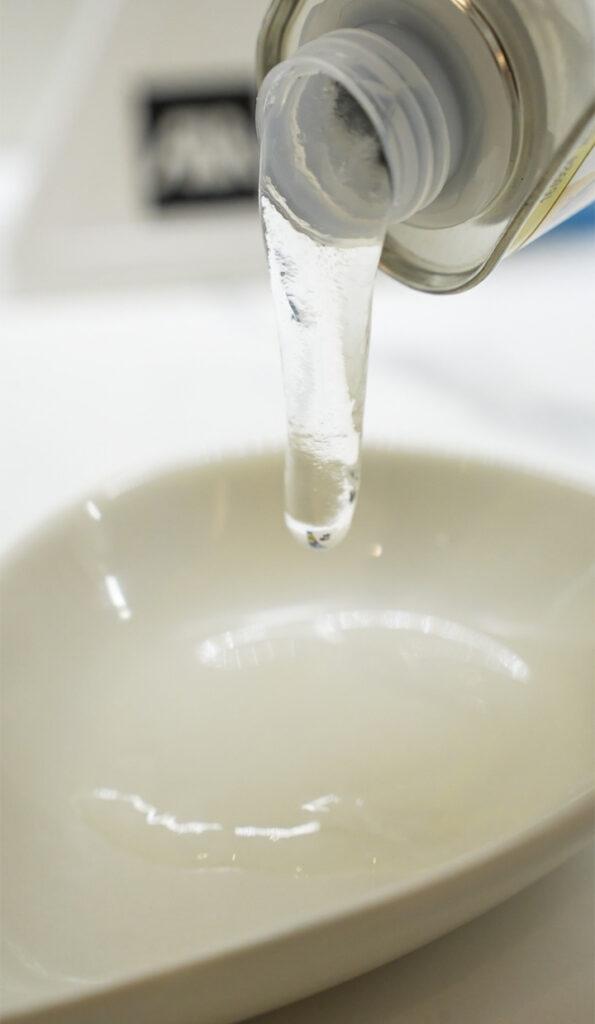


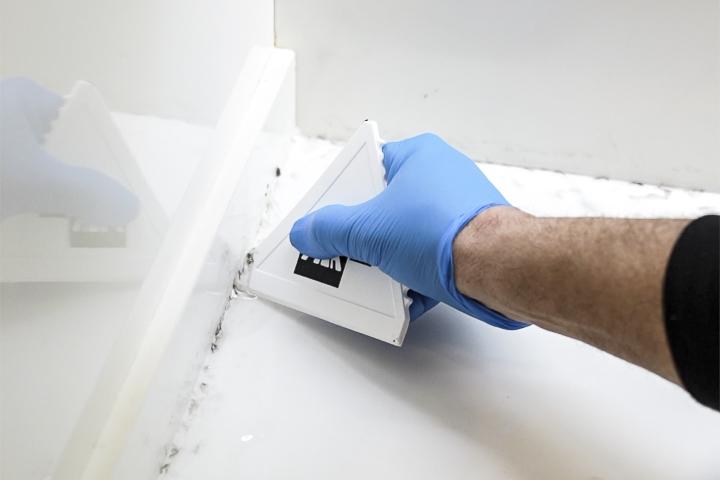
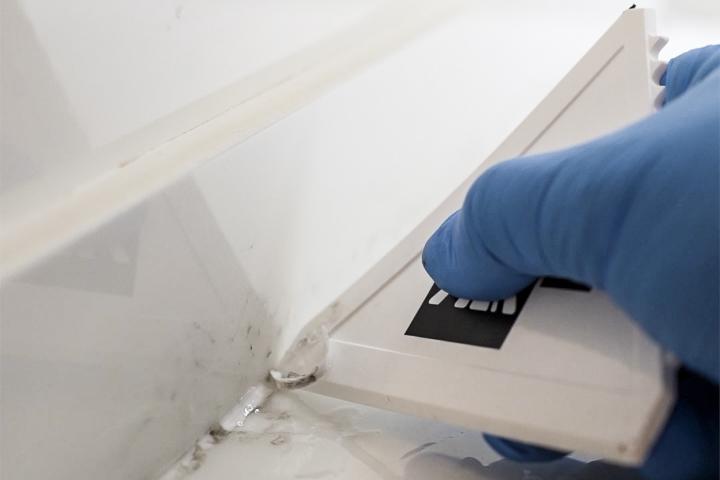
De esta manera obtenemos una junta limpia y libre de silicona lista para aplicar el nuevo sellante. Para un acabado perfecto y sin burbujas de aire, una vez se ha rellenado la junta con un nuevo cordón de silicona, pulverizar SILICONE REFINER y pasar una espátula.

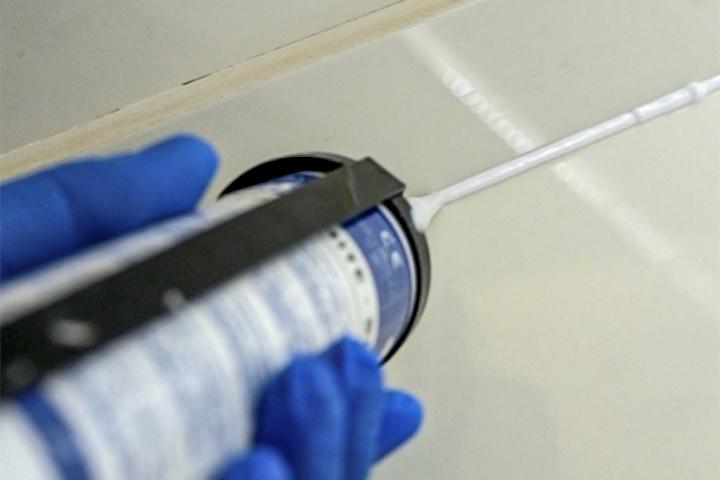


SILICONE REFINER es una solución en fresco que evita la adherencia de residuos facilitando el acabado de todo tipo de silicona y sellantes (incluidos MS) justo después de la aplicación.
No deja residuos y respeta todas las superficies.
Con este paso conseguimos un sellado uniforme que evita la proliferación de moho y bacterias, asegurando un acabado limpio y duradero.
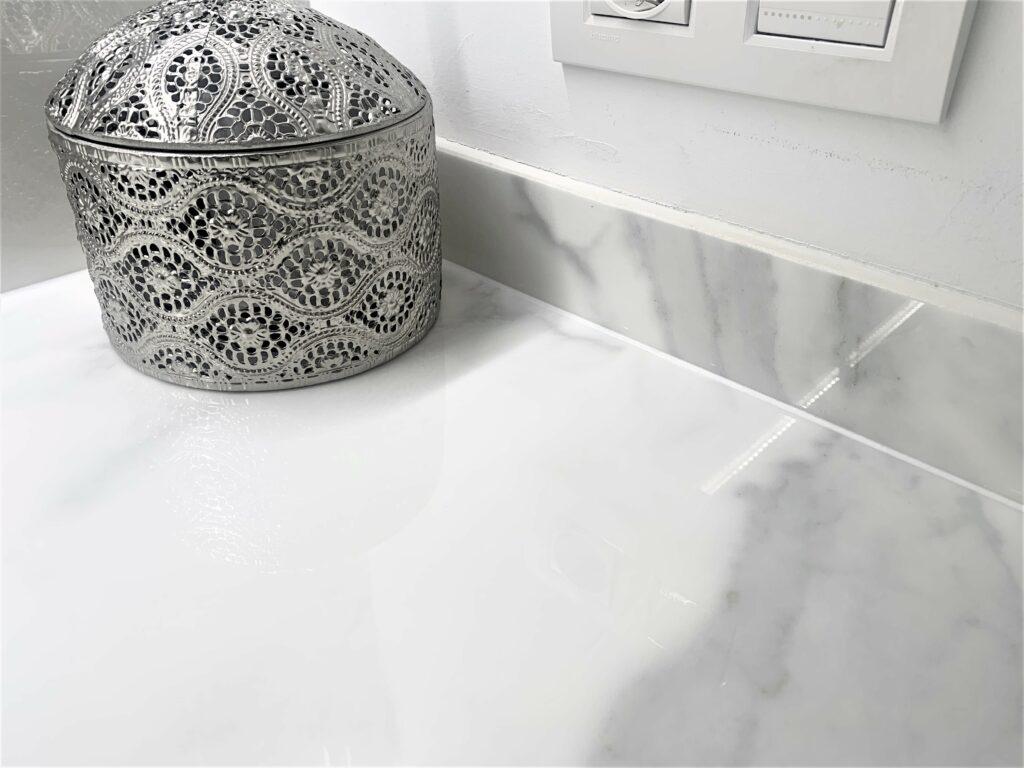
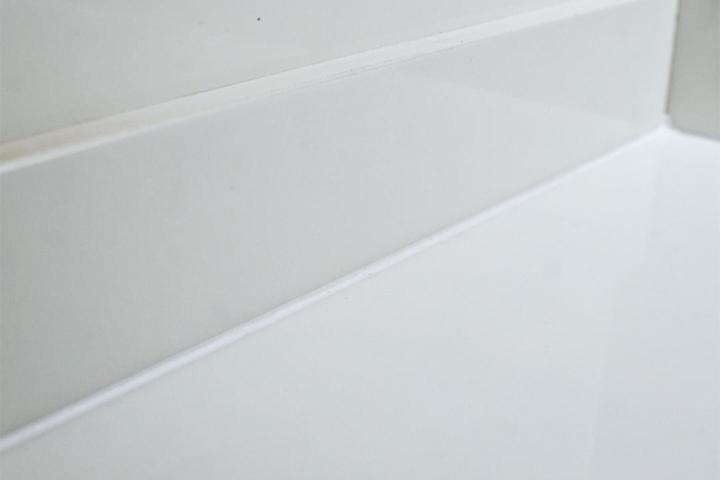
DESCUBRE CÓMO ELIMINAR RÁPIDAMENTE LOS RESIUOS DE SILICONA Y DE COLA DE LAS SUPERFICIES
Lo habitual al decidir una reforma del hogar es centrarse en los materiales, la distribución o el aislamiento térmico. Es comprensible que todo lo que tiene que ver con la estética y el confort diario ocupe el centro de las prioridades. Sin embargo, hay una parte igual de importante que en la mayoría de las ocasiones se deja para el final o directamente se ignora; se trata de la seguridad del inmueble. Incluirla desde el inicio del proyecto ahorrará complicaciones futuras y garantizará que esté verdaderamente integrada en el diseño.
Colocar alarmas para el hogar durante la reforma va a permitir planificar mucho mejor su ubicación, el paso del cableado o el tipo de sensor más adecuado para cada zona. En lugar de adaptar la instalación a una obra ya terminada, se hace al revés, adaptando la reforma al sistema de seguridad, con lo que se evitarán futuras regolas, el cambio de puntos de luz o la colocación de sensores en lugares visibles que rompen la estética.
Además, planificar este tipo de sistemas con el equipo técnico o arquitectónico desde la fase de proyecto ayuda a tomar mejores decisiones estructurales y de distribución. Por ejemplo, es posible diseñar un falso techo o una canaleta que oculte totalmente el sistema sin afectar la estética, o reforzar con materiales adecuados los puntos de acceso más sensibles.
Demasiadas personas pasan por alto al reformar que la propia arquitectura suele influir en los puntos débiles de una casa. No es lo mismo una vivienda en planta baja que un ático, ni una casa con jardín que un piso en altura.
Así mismo, los elementos interfieren claramente, convirtiéndose en focos de riesgo si no se tienen en cuenta desde el principio, como, por ejemplo;
Pensar en seguridad en la fase de diseño, además de ser una cuestión técnica, es una forma de vivir más tranquilo. Y en este punto, empresas como ADT Seguridad, con más de un siglo de experiencia en el sector, ofrecen un catálogo de soluciones adaptadas tanto a viviendas nuevas como a reformas. Desde sensores perimetrales hasta cámaras, elementos de seguridad que se instalan de forma discreta y eficaz si se planifica bien desde el primer minuto.
La evolución tecnológica permite hoy en día sistemas mucho más compactos, conectados e intuitivos. No es necesario llenar la casa de cables ni equipos voluminosos; la tendencia va hacia una seguridad inteligente, que se adapta al usuario y se anticipa a los riesgos.
Por otro lado, si se tiene pensado crear un sistema que se integre con la domótica de la casa, se logrará la automatización de funciones que van más allá de la seguridad, como la iluminación que se enciende al detectar movimiento, notificaciones en el móvil cuando alguien accede, control remoto para desactivar alarmas o abrir la puerta a distancia, etc.
Hoy en día, hablar de seguridad también implica hablar de eficiencia. Los dispositivos que consumen menos energía, los sensores con tecnologías de bajo voltaje o los sistemas de reposo inteligente forman parte de un enfoque más sostenible.
Incorporar soluciones eficientes ayuda al medioambiente y reduce la factura eléctrica, alargando la vida útil del sistema. Es una inversión inteligente que encaja perfectamente con el espíritu de muchas reformas actuales, que no es otro que la creación de viviendas más cómodas, responsables y preparadas para el futuro.
Además, muchos de estos sistemas pueden alimentarse mediante fuentes de energía renovables, como pequeños paneles solares, o integrarse en una vivienda con certificación energética avanzada. Es otro motivo para considerarlos desde el diseño arquitectónico y no como una instalación adicional de última hora.
A todo esto, se suma el hecho de que una buena instalación de alarmas para el hogar puede influir positivamente en el seguro. Muchas compañías lo tienen en cuenta a la hora de establecer las condiciones de la póliza o valorar una posible rebaja. Si el sistema está homologado y bien mantenido, protegerá la casa a la par que el bolsillo.
Reformar es redefinir cómo se habita un espacio, es crear un lugar con la verdadera personalidad de quien lo habita. Y si se va a invertir tiempo, esfuerzo y dinero en hacerlo a medida, ¿por qué no incluir también aquello que hace sentir más protegido?
La seguridad es parte del confort. Y si se trabaja desde el inicio, junto a profesionales, puede integrarse en el diseño de manera natural, sin restar belleza ni funcionalidad. Con soluciones como las que propone ADT Seguridad, la tranquilidad pasa a formar parte de tu hogar.
El próximo 4 de noviembre 2025, a las 12h, la prestigiosa Bodega Katxiña en Orio se convertirá en el escenario de un encuentro exclusivo: Pamesa MeetDesign. Esta jornada reunirá a reconocidos estudios de arquitectura y diseño para disfrutar de una experiencia que combina inspiración creativa, innovación en cerámica y un entorno enogastronómico inigualable.
Bajo el lema “La vanguardia arquitectónica maridada con tradición vinícola”, el evento invita a descubrir cómo la excelencia en el diseño y la innovación cerámica encuentran puntos de unión con la cultura del vino y la autenticidad de un paisaje único.
Durante la jornada, los asistentes recorrerán la bodega y sus viñedos, disfrutando de una visita guiada en la que se desvelará el proceso de elaboración de sus vinos. Posteriormente, participarán en una cata exclusiva de las variedades más representativas de la casa, acompañada de una experiencia gastronómica diseñada para resaltar los aromas y sabores del territorio.
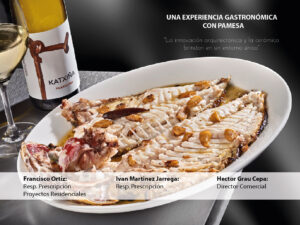
Francisco Ortiz, portavoz de Pamesa Cerámica, compartirá la visión de la compañía y presentará sus últimas innovaciones en diseño y soluciones constructivas, reafirmando el liderazgo de la firma en el sector.
El evento no solo será una oportunidad para conocer de cerca las tendencias más recientes en cerámica y arquitectura de vanguardia, sino también para disfrutar de un entorno natural que realza la autenticidad de la experiencia.
Pamesa MeetDesign en Bodega Katxiña promete convertirse en un espacio de conexión, intercambio de ideas y celebración de la creatividad, donde el diseño, la arquitectura y la cultura vinícola se encuentran en perfecta armonía.



Gresmanc Group, compañía líder en la fabricación de cerámica extrusionada de alto valor añadido, abre su nuevo showroom en el corazón de Madrid, situado en Calle Velázquez 76. Un espacio exclusivo especialmente dirigido a profesionales de la arquitectura y el diseño, quienes descubrirán de primera mano las exclusivas soluciones en cerámica extrusionada para pavimentos, piscinas y fachadas ventiladas, que combinan innovación, diseño y sostenibilidad.
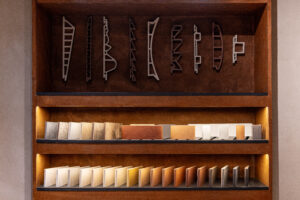
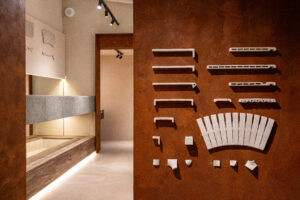


El proyecto ha sido diseñado por Summum Studio, que ha creado un singular entorno expositivo concebido para resaltar las cualidades técnicas y estéticas de los productos cerámicos de Gresmanc Group, que son el reflejo de una empresa con profundos arraigos a sus raíces y a su tierra, que mantiene un firme compromiso con el respeto al medio ambiente, integrando procesos de fabricación responsables y soluciones cerámicas de larga durabilidad.
Como evento pre inaugural, el nuevo showroom de Gresmanc Group acogerá la obra pictórica del Dr. Enrique Rojas, reconocido psiquiatra y apasionado artista, cuya pintura abstracta y llena de color encuentra una resonancia inesperada pero profunda con su propia materia: la cerámica.
Gresmanc Group trabaja con un material noble, versátil y duradero, que se moldea con precisión técnica, pero siempre con una mirada hacia la estética, la textura, la luz y el color. Del mismo modo, la pintura del Dr. Rojas transforma el lienzo en un territorio de expresión emocional, donde el color no solo embellece, sino que comunica y evoca.
Esta colaboración es un encuentro entre dos mundos que, aunque distintos en forma, comparten una misma esencia: la capacidad de transformar espacios y estados de ánimo. Así como una fachada cerámica puede dialogar con su entorno y mejorar la experiencia arquitectónica, la obra del Dr. Rojas invita a una introspección sensorial y emocional, ofreciendo una mirada diferente a lo cotidiano.
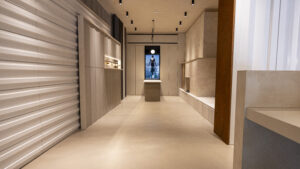
Son trabajos con superficies: Gresmanc Group, las de los espacios que habitamos; el Dr. Enrique Rojas, las de la psique. Y en ambos casos, el color y la materia son los lenguajes que empleamos para construir belleza, armonía y bienestar.
Les invitan a descubrir esta exposición, que convierte este espacio en un lugar de diálogo entre la técnica y la emoción, entre la cerámica y la pintura, entre la arquitectura del exterior y la del interior humano.
Del 15 de septiembre al 4 de octubre de 2025.
De L-V de 9:30 a 20:00 h y sáb. de 11h a 14h
Madrid. Calle Velázquez, 76.
Las soluciones de Saint-Gobain Glass, líder en fabricación de soluciones de vidrio plano para fachadas, ventanas y diseño de interiores, han sido elegidas para el diseño del nuevo Edificio LLULL, situado en el barrio barcelonés de Poblenou.
Este edificio de oficinas de siete plantas, diseñado por el estudio BAAS ARQUITECTURA, se define como una pieza arquitectónica que combina transparencia y solidez. El volumen retrocede unos cuantos metros para dejar una pequeña plaza pública en la esquina que adopta la forma singular de una fachada escalonada, permitiendo que cada planta cuente con su propia terraza ajardinada, generando una mayor amplitud. Además, la estructura de soporte de hormigón va acompañada de dos grandes pilares inclinados que sostienen el edificio y le confieren una visión estética más atractiva.
Por otro lado, el núcleo adosado a la medianera también es construido en hormigón, donde se alojan la escalera, los ascensores, los baños y dos patios verticales que se encuentran abiertos al exterior. De esta forma, se genera una mayor accesibilidad a las instalaciones necesarias, aprovechando mejor los espacios de trabajo.
Las fachadas laterales se construyen a partir de un ritmo de pilares que sobresalen y protegen las ventanas del impacto directo del sol. Asimismo, las terrazas se cubren mediante toldos tradicionales que se gestionan de forma automática en función de las condiciones solares. El proyecto apuesta por dar prioridad a los materiales para que visualmente desaparezcan todos los revestimientos, mostrando así una visión real de la construcción y diseño del edificio.
Uno de los objetivos del edificio Llul era ofrecer un excelente nivel de confort para los ocupantes de estas oficinas, garantizando una temperatura adecuada y la máxima entrada de luz natural posible. Por ello, la fachada exterior de vidrio ha sido realizada con la solución COOL-LITE® SKN 183 y COOL-LITE® XTREME 70/33, instalado en las plantas superiores. Este vidrio de alta selectividad combina la mayor transmisión luminosa (TL 75%) con un alto aislamiento térmico con baja transmitancia y un control solar eficiente. Ello ha conferido a la envolvente una alta selectividad y una estética neutra, transparente y menor reflexión luminosa exterior. Gracias a este muro cortina, los ocupantes de estas oficinas disfrutarán de un confort térmico elevado y una gran entrada de luz natural.
Tanto en las plantas bajas del edificio como en la fachada orientada a la plaza, se ha optado por el doble acristalamiento PLANITHERM® XN en ventanas. Este vidrio de capa de baja emisividad ha proporcionado un aislamiento térmico reforzado, reduciendo así el intercambio energético que se produce a través de las ventanas, lo que a su vez ha contribuido a maximizar la eficiencia energética del edificio.
Todas las soluciones de Saint-Gobain Glass instaladas en este proyecto responden al compromiso de la marca de construir mejor para las personas y el planeta, siempre guiado por el propósito común del Grupo Saint-Gobain “MAKING THE WORLD A BETTER HOME”.
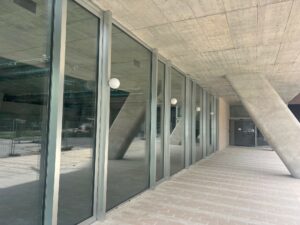
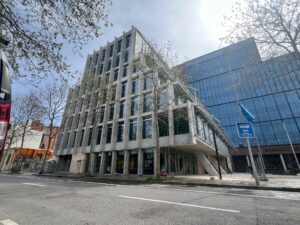
Saint-Gobain Glass se compromete a construir mejor para las personas y el planeta ofreciendo soluciones de vidrio plano para fachadas, ventanas y diseño de interiores que proporcionan sostenibilidad con las más altas prestaciones. En España cuenta con un centro de producción en Avilés, Asturias, que comprende un horno float y líneas para la fabricación de vidrios con capa, donde también se encuentra su centro de I+D, el AR&DC
Saint-Gobain Glass se ha posicionado como líder en el mercado ofreciendo soluciones de vidrio con capa de alto valor añadido que cuentan con aislamiento térmico reforzado, control solar y seguridad, así como la fabricación de espejos y vidrios de seguridad laminados. Es propietaria de la marca CLIMALIT®, pionera y líder en el mercado de dobles y triples acristalamientos aislantes, así como de la marca para el vidrio templado SECURIT®, que la Red de transformadores de vidrio utilizan, bajo licencia, para la comercialización de ambas soluciones.
Líder mundial en construcción ligera y sostenible, Saint-Gobain diseña, fabrica y distribuye materiales y soluciones para los mercados de la construcción, movilidad e industria. Todas nuestras marcas se guían por un propósito común: “MAKING THE WORLD A BETTER HOME”.

Nuestros encuentros de Networking se visten de gala con la presencia del renombrado arquitecto Boris Veliz, con 15 años de experiencia internacional en práctica arquitectónica sostenible, liderando proyectos desde la concepción hasta la ejecución. En los últimos 3 años, he centrado su trabajo en integrar conocimiento e innovación en nuevas áreas de negocio, con el objetivo de desarrollar sistemas urbanos más sostenibles y mejorar el entorno construido.

Paduleta Kalea, 53, 01015
Vitoria-Gasteiz, Araba
Además, durante el NETWORKING Activo, podrás participar en sesiones exprés impartidas por nuestro equipo de profesionales, donde se abordarán diversas temáticas relacionadas con la arquitectura sostenible y la innovación en el sector. .
Este evento es la ocasión perfecta para profesionales y empresas comprometidos con la construcción sostenible. Será un espacio único para intercambiar ideas, establecer colaboraciones y aprender de las mejores prácticas del sector, todo mientras disfrutas de una experiencia incomparable de networking.

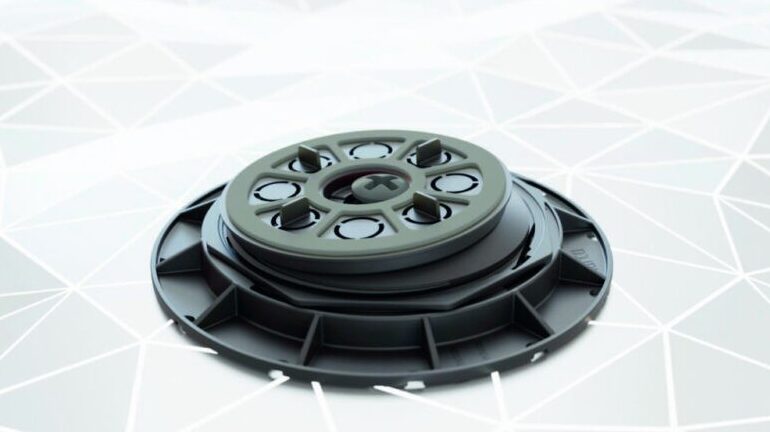

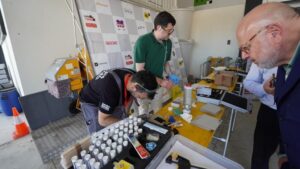



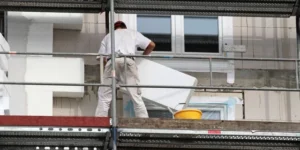
eventos@tureforma.org
+34 964 246 950
+34 722 207 518
La próxima edición de Feria Hábitat València ultima ya los detalles de una multitudinaria edición que se celebrará junto a Textilhogar en Feria Valencia del próximo 29 de septiembre al 2 de octubre. Una feria de gran formato en la que está confirmada la presencia de más de 700 firmas y marcas expositoras procedentes de una veintena de países, pero en la que, sin duda, será protagonista una intensísima agenda de conferencias, actividades, charlas, mesas redondas y presentaciones de producto.
Serán en total más de un centenar de actos que se desarrollarán en dos escenarios: el Ágora nude, ubicado junto a la muestra de talento en diseño en el Nivel 3 Pabellón 4, y la Zona de Conferencias de Hotel Hábitat, al fondo del Nivel 3 Pabellón 3 y junto a la inspiradora instalación hotelera de Tomás Alía. A todo lo que suceda en estos dos foros hay que sumarle el más de medio centenar de presentaciones, ‘cocktails’ o encuentros previstos por los propios expositores en sus respectivos stands.
Ágora nude, donde las tendencias se encuentran con el diseño
Será el centro de atracción para todos los profesionales del mundo del diseño así como los ‘coolhunters’ más atrevidos. Cada año se convierte en un punto ineludible de conexión para los profesionales del sector, y este año no será diferente, con conferencias tan destacadas de figuras de primer nivel como Alberto Cavalli, director ejecutivo de la Michelangelo Foundation, el flamante último Premio Nacional de Diseño, Héctor Serrano o uno de los creadores del momento como José Manuel Ferrero de Estudi{H}ac, quien ha diseñado precisamente todo el espacio de nude 2025. El Ágora nude de este año también será escenario donde se presente, entre otras iniciativas, el Concurso Internacional de Diseño de Andreu World, el Mapa del Diseño de Alicante, la primera edición de los Premios Nacionales de Diseño Interior (DIN), el proyecto FITT-NESS en torno a las ‘smart homes’ o una nueva edición del Cuaderno de Tendencias del Hábitat.
También destacarán las conferencias en torno a la prescripción de materiales, la propiedad intelectual en el mundo del diseño, el presente del diseño español, la presentación de la iniciativa Hábitat 360 de Finsa (firma impulsora del Salón nude) o una charla en torno a las sinergias entre los profesionales del diseño.
La feria pondrá el foco este año en torno a la artesanía contemporánea a través de diversas exposiciones y charlas como la que está prevista en el Ágora nude en torno a la puesta en valor de la artesanía contemporánea desde el diseño, que contará con la participación de Chisco Vilar, del Ministerio de Cultura y Deporte del Gobierno de España, uno de los organismos que impulsan el Salón nude.
Por último, los asistentes al Ágora nude no deben de pasar por alto iniciativas tan interesantes como la conferencia de una de las eminencias en medicina del sueño, la doctora Núria Roure, en torno a la importancia del descanso, en una conferencia desarrollada por la firma de colchones Gomarco.
También destaca la mesa redonda en torno a diseño e industria impulsada por Actiu y la iniciativa ‘Altavoz, dando voz al diseño valenciano’, a través de la cual la Asociación de Diseñadores de la Comunitat Valenciana (ADCV) permite a varios estudios de diseño pertenecientes a la ADCV presentar sus piezas expuestas en el certamen. Cada participante contará con solo tres minutos para dar a conocer sus proyectos y compartir el valor estratégico que hay detrás de cada creación.
La industria hotelera se cita en Feria Hábitat València 2025
Por otro lado, esta edición de Hábitat volverá a poner el foco en la industria hotelera para convocar a las mayores cadenas del país y los profesionales del sector hotelero. Tomás Alía ideará un hotel sostenible a través de la inspiración de la arquitectura popular valenciana y, en la zona de conferencias de esta instalación se celebrarán unas jornadas monográficas en torno a las claves de futuro de este sector.
Así, durante la mañana del lunes 29 y martes 30 de septiembre y con el impulso de organismos sectoriales como HOSBEC, ITH o CEHAT se desarrollarán jornadas en torno al futuro del turismo, las estructuras jurídicas para la operación hotelera de la mano del despacho jurídico Garrigues– o una conferencia en torno a cómo identificar, evaluar y aprovechar oportunidades en el sector hotelero.
Pero, además, este escenario se nutrirá de diversos coloquios en el que arquitectura, proyectos, contract y hoteles serán protagonistas y de la mano de destacados profesionales del sector. Es el caso de un coloquio entre Héctor Ruiz-Velázquez, la jornada ‘Women in Office Design’ impulsada por Actiu y que contará, entre otros, con Francesca Heathcote, de Teresa Sapey + Partners, o la conferencia de Francesc Rifé en torno al Grupo Lamadrid.
Este foro también acogerá a destacados profesionales internacionales como el arquitecto y diseñador chino Ben Wu o el italiano Gabrielle Buratti, en una conferencia organizada por Alexandra, así como un monográfico que en la mañana del jueves 2 de octubre reunirá a destacados profesionales de la arquitectura y el negocio inmobiliario como Fran Silvestre o José Martí de Erre Arquitectura.
La completísima agenda en torno al contract hotelero la completarán conferencias como la que impartirá Tomás Alía en torno a la artesanía, la presentación de la guía ‘Viajar bien sentado’ de Andreu World, una mesa redonda en torno al impacto de la sostenibilidad en los departamentos de compras, una conferencia sobre materiales para contract y su reacción al fuego o la presentación del nuevo sistema ‘Ziclick’ para la rehabilitación interior de hoteles.
Los expositores presentan sus nuevos diseños y colecciones
El tercer gran foco de actividades de esta edición de Hábitat será el gran número de presentaciones y encuentros con prensa y visitantes que están organizando los expositores en sus propios stands. Y es que este año, la feria es elegida por las grandes firmas del hábitat para mostrar sus últimas colecciones de la mano, en su gran mayoría, de diseñadores y credores de relumbrón.
Un ejemplo de ello será la presencia del controvertido diseñador norteamericano de origen egipcio, Karim Rashid, que presentará una nueva colección de la firma de descanso Nisi Family. Hábitat también acogerá la presencia, por ejemplo, de la creativa Agatha Ruiz de la Prada, de la mano de La Premier o la talentosa diseñadora germana Meike Harde, que presentará su colaboración con Viccarbe.
La lista es extensa, y entre ellos destacará la presencia del italiano Stefano Spessoto para Santalucia Mobili, la presentación de Ximo Roca para Systemtronic; Francesc Rifé para Uecko, el italiano Giancarlo Vegni y su nueva colección para Casadesús o la presencia en el stand de Point de los afamados diseñadores Patrick Norguet y Boti de Dominicis para presentar sus nuevas colecciones para la firma alicantina.
Ramón Esteve no podía fallar a su cita con Hábitat y presentará su esperado nuevo sofá en el stand de Vondom, al igual que la nueva colección de Daniel Germani para Zavotti o la presentación de Emiliana Design de mobiliario inclusivo para Vergés.
Tola la información de la agenda está ya disponible en:
https://www.feriahabitatvalencia.com/agenda-de-actividades-2025/
Hábitat y Textilhogar: una oferta única con poder de convocatoria internacional
Feria Valencia acogerá del próximo 29 de septiembre al 2 de octubre la celebración conjunta de las ferias de referencia del mueble, iluminación, decoración, textiles para el hogar, tapizado y contract. De este modo, Feria Hábitat València y Textilhogar Home Textiles Premium conforman el mayor escaparate en torno al hogar y el contract de nuestro país en una convocatoria de gran formato y de gran poder de convocatoria tanto nacional e internacional. Una fórmula de éxito de más 90.000 metros cuadrados de superficie expositiva y más de 43.000 visitantes profesionales procedentes de 70 países.
+ info
Los días 1 y 2 de octubre tendrá lugar la tercera edición de Cerámica en Vivo, el encuentro que organiza la Central BdB junto a sus principales Proveedores y que ya se ha convertido en una cita esperada por todos los Asociados de la red. Estas jornadas tienen el objetivo de ayudar al Asociado en el desarrollo de su negocio en la categoría de Cerámica y Baño.
En esta ocasión, una de las grandes novedades será la visita al nuevo showroom de la Central BdB, un espacio diseñado para inspirar y servir como referencia a los Asociados en sus futuros proyectos. Este nuevo entorno, que refleja las últimas tendencias del sector, se convertirá en un punto clave dentro del programa de actividades.
Durante las dos jornadas, los participantes también podrán disfrutar de visitas a fábricas y exposiciones de proveedores colaboradores, que abrirán sus puertas para mostrar de cerca procesos y novedades, así como de sesiones formativas en las propias instalaciones de la Central BdB.
La noche del 1 de octubre se vivirá uno de los momentos más especiales del encuentro, con una cena de gala en el Estadio de la Cerámica, el hogar del Villarreal CF, cortesía de la marca Prissmacer, que aportará un escenario único y memorable a esta edición.
Con Cerámica en Vivo, BdB vuelve a apostar por la formación continua, el contacto directo con los proveedores y el fortalecimiento de la comunidad de Asociados, en un evento que une conocimiento, innovación y cercanía.
Sobre BdB
BdB es una central de compras y servicios con marca de canal con almacenes de construcción repartidos a lo largo de toda España y en Portugal. Las tiendas BdB son empresas profesionales de distribución de materiales de construcción, ferretería, cerámica y baño.
Ideal Standard, parte de la división Bathroom & Wellness del Grupo Villeroy & Boch, refuerza su gama de productos para la ducha con tres nuevas colecciones que combinan diseño inteligente, alto rendimiento y durabilidad, manteniendo una excelente relación calidad-precio.
Diseñadas para ofrecer la máxima flexibilidad, Ceratherm, Ceraflow y Ceratwist ofrecen una selección de sistemas de ducha termostáticos, monomando y con desviador para satisfacer una gran variedad de necesidades, tanto en entornos residenciales como hoteleros.
Ceratherm
Ofrece soluciones termostáticas innovadoras gracias al cartucho PreciTherm, que combina un control preciso de la temperatura con una resistencia excepcional.
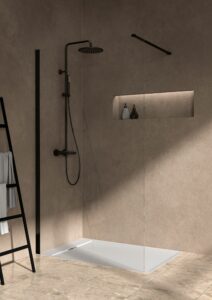
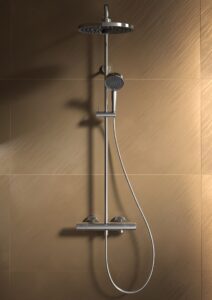
La renovada línea Ceratherm T25 incorpora duchas fijas de mayor tamaño y un mezclador con cuerpo íntegramente cromado, que destaca por su diseño cilíndrico, refinado y minimalista. Sus manetas ergonómicas, equipadas con un botón cromado y una superficie antideslizante, garantizan un manejo cómodo y preciso, mientras que la tecnología CoolBody protege frente a posibles quemaduras.
Equipada con funciones de ahorro de agua, como el limitador Ecostop al 50 % y un tope de temperatura de bajo consumo, Ceratherm T25 está disponible en grifería de pared, conjuntos de ducha y bañera, así como en sistemas completos, convirtiéndose en una solución versátil y eficiente para el baño contemporáneo.
Ceratwist
Capaz de adaptarse a cualquier entorno, Ceratwist es una nueva gama de sistemas de ducha con desviador que se combina a la perfección con una gran variedad de griferías empotradas, reafirmando su versatilidad en cualquier cuarto de baño.

Ceraflow
Pensada para ofrecer un control fiable y eficiente, Ceraflow es una colección de sistemas de ducha monomando que funcionan con el cartucho FirmaFlow®+. Con un funcionamiento suave y estable durante más de 750 000 ciclos (diez veces más que la norma europea) asegura un rendimiento duradero.
Una ducha para cada preferencia
La serie T25 dispone de una ducha fija con una función llamada Rain y una ducha de mano con dos funciones: Rain y SilkRain. Los modelos T25+ y Alu+ ofrecen dos funciones tanto en la ducha fija como en la de mano.
T25M combina una ducha fija metálica con chorro tipo lluvia y una elegante y minimalista ducha de mano metálica que ofrece una combinación de estilo y funcionalidad. Todos los modelos cuentan con grandes duchas fijas, disponibles en tamaños de 260 mm o 250 mm, con opciones redondas y cuadradas, junto con una ducha de mano de generosas dimensiones de 100 mm.
Además, todas las versiones incorporan boquillas EasyClean para un mantenimiento sin esfuerzo y limitadores de caudal que ahorran agua (12 l/min para duchas fijas y 8 l/min para duchas de mano, con variantes de bajo caudal de 8 y 6 l/min, respectivamente). La instalación se simplifica gracias al soporte metálico de pared EasyMount, con un ajuste vertical para reutilizar los orificios existentes.
«Hemos desarrollado nuestras últimas colecciones de ducha para ofrecer una gama clara y estructurada que combina a la perfección un diseño inteligente y características de confort con un rendimiento duradero y un precio asequible», afirma Sven Ullrich, vicepresidente ejecutivo de Marketing, Gestión de Productos e I+D de Villeroy & Boch.
«Al ofrecer una amplia gama de soluciones termostáticas, monomando y desviadoras, permitimos tanto a particulares como a profesionales seleccionar el producto ideal para satisfacer sus necesidades. Estas nuevas soluciones para duchas se benefician de las décadas de experiencia de Ideal Standard en la fabricación de grifería. Diseñados en Wittlich (Alemania) y fabricados en Europa con materiales de la más alta calidad, todos los productos que salen de nuestras plantas son sólidos, duraderos y están fabricados según los más altos estándares».
Acerca de Ideal Standard
Ideal Standard, que forma parte de la División de Bathroom & Wellness del Grupo Villeroy & Boch, es una marca líder mundial en soluciones de alta calidad para baños residenciales, comerciales y sanitarios. Su cartera combina productos de baño elaborados por expertos, incluyendo cerámica, grifería, baño, muebles y accesorios, ofreciendo una gama integral de soluciones para todas las categorías.
Acerca de la División de Bathroom & Wellness del Grupo Villeroy & Boch
El Grupo Villeroy & Boch es uno de los líderes mundiales en productos de primera calidad para la restauración y el estilo de vida, así como para el baño y bienestar. Fundada en 1748 y con sede en Mettlach (Alemania), la empresa es sinónimo de innovación, diseño y calidad. El Grupo cuenta con más de 12.000 empleados y está presente en más de 125 países de todo el mundo.
Con su sólida cartera de marcas, la División de Bathroom & Wellness del Grupo Villeroy & Boch ofrece una amplia gama de productos sanitarios y accesorios para edificios residenciales y no residenciales. La cartera combinada ofrece a consumidores, clientes y socios de todo el mundo una amplia selección de productos individuales hasta soluciones completas para cuartos de baño. Más de 300 ingenieros de los centros de diseño e innovación de Alemania e Italia desarrollan conceptos que destacan por su calidad, funcionalidad y diseño puntero.
La ceremonia de entrega de premios de la primera edición del Concurso Nacional de Fotografía de Arquitectura e Interiorismo X-PACE PHOTO CONTEST organizado por Fujifilm y Cosentino, se ha celebrado en Cosentino City Madrid, rindiendo homenaje a la arquitectura, diseño de interiores y a la mirada creativa de los profesionales que trabajan en estas disciplinas.
La velada se ha convertido en una auténtica celebración de talento, donde cada fotografía no solo ha retratado el espacio y las estructuras, sino que también ha invitado a los asistentes a imaginarse cómo la luz y las perspectivas transforman lo cotidiano en una experiencia única y emocional.
Además, el acto ha reunido a destacados profesionales del sector como el arquitecto Héctor Ruíz Velázquez, el fotógrafo de arquitectura Nando Esteva, la diseñadora de interiores, Miriam Alía, y el arquitecto y fotógrafo de arquitectura Nicanor García, estos tres últimos miembros del jurado, entre otros, cuya presencia enriqueció la velada y dio lugar a un valioso diálogo sobre creatividad, arquitectura, interiorismo, espacios y fotografía.
Más de 1400 archivos recibidos han conmemorado el reflejo de una gran diversidad de estilos y perspectivas, y cerca de 600 concursantes han convertido esta primera edición en un certamen marcado por la creatividad y la profesionalidad.
“Fujifilm Imaging da la gracias y está satisfecha por el nivel de participación de los fotógrafos. Estamos contentos de llevar a cabo iniciativas artísticas donde creamos sinergias entre dos disciplinas artísticas como son la arquitectura y la fotografía. Queremos seguir avanzando en el campo de la fotografía de arquitectura e interiorismo apoyando a los profesionales con nuestras cámaras digitales de última generación, para que puedan presentar sus proyectos por las vías más artísticas”, ha querido expresar Eduardo López, director de Imaging y Recording Media en Fujifilm España.
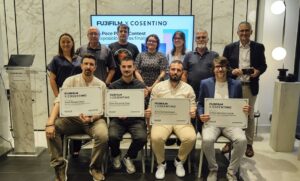
“El propósito principal de estos premios se ha cumplido. Estamos felices de esta colaboración de la mano de Fujifilm, es un paso más en nuestro camino de apoyar a arquitectos e interioristas ofreciéndoles oportunidades de visibilizar sus proyectos. Además, de esta primera edición esperamos que tenga lugar una segunda, tercera y muchas más. Nos complace anunciar que la exposición del espacio Cosentino City Madrid también viajará a Cosentino City Barcelona”, declara Isabel Martinez-Cosentino, Consejera de COSENTINO.
La colaboración entre las dos compañías organizadoras del concurso no solo ha unido talento, sino que ha fortalecido el objetivo de promover la creatividad y ofrecer una plataforma para mostrar las nuevas perspectivas de la arquitectura e interiorismo a través de la lente de una cámara.
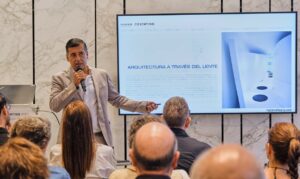
Un diálogo visual entre la arquitectura y el espacio
Según Héctor Ruíz Velázquez, “cada espacio es un territorio a conquistar: un lugar donde la luz, la materia y la emoción se encuentran. La fotografía de arquitectura tiene el poder de capturar esa conquista y transformarla en memoria compartida, revelando cómo habitamos y sentimos cada proyecto”.
Por su parte, Nando Esteva ha explicado que observa e interpreta desde que ángulo mirar y fotografiar. “En mi mundo saturado de imágenes, donde lo espectacular muchas veces sustituye a lo esencial, creo que el verdadero reto está en respetar la arquitectura siendo muy honesto con el espacio y el lugar. Me interesa capturar el alma de los espacios, no solo sus líneas o proporciones”, afirma el fotógrafo de arquitectura.
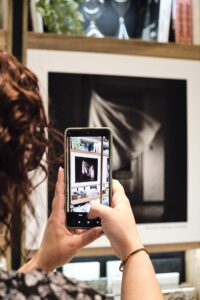
Premiados I Concurso Concurso Nacional de Fotografía de Arquitectura e Interiorismo X-PACE PHOTO CONTEST
Categoría 1er premio arquitectura Toni Palomares – premio una cámara digital FUJIFILM GFX100RF
Categoría 2º premio arquitectura Carlos Sánchez García – premio una cámara FUJIFILM X100VI
Categoría 1er premio interiorismo José Williams – premio una cámara digital FUJIFILM GFX100RF
Categoría 2º premio interiorismo Jordi Renart Roca – premio una cámara FUJIFILM X100VI
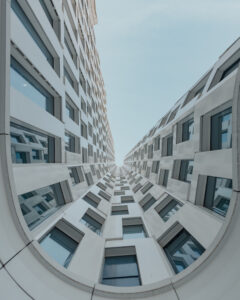
Exposiciones
La exposición con los proyectos ganadores y finalistas podrá visitarse en Cosentino City Madrid del 10 al 15 de septiembre. Posteriormente, se trasladará a Cosentino City Barcelona del 18 al 30 de septiembre y continuará de manera itinerante.
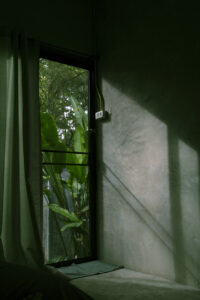
Cámaras Digitales de Fujifilm
Durante la ceremonia se han mostrado los últimos equipos de Fujifilm GFX100II + GF30mm TS, GFX100RF, X-E5 y X100VI
Acerca de Fujifilm en Europa
Fujifilm cuenta con más de 50 empresas del grupo y sucursales en Europa. En España, concretamente en Barcelona y Madrid. Además, emplea a más de 6.000 personas, de las cuales cerca de 200 trabajan en Fujifilm España, dedicadas a I+D, fabricación, ventas y servicios, con FUJIFILM, situada en Ratingen, Alemania, como sede estratégica para la región. En toda Europa, las sucursales de Fujifilm prestan servicio a una serie de industrias que incluyen: tecnología médica, productos biofarmacéuticos, materiales electrónicos, productos industriales, productos químicos, sistemas gráficos, dispositivos ópticos, almacenamiento de datos y todos los aspectos relacionados con la fotografía. En los últimos 20 años, la empresa se ha centrado más intensamente en el área de salud, desde el diagnóstico hasta la prevención y el tratamiento. En la actualidad, Fujifilm en Europa ofrece todo el espectro de la atención al paciente, además de la investigación, el desarrollo y la fabricación de terapias avanzadas, terapias génicas y vacunas, así como el suministro de medios de cultivo celular y soluciones de medicina regenerativa.
Para más información, visite: https://www.fujifilm.com/es/es-es/consumer/digitalcameras
Sobre Cosentino
Cosentino es una compañía global, española y de propiedad familiar, que produce y distribuye superficies innovadoras de alto valor para el mundo de la arquitectura y el diseño. Como empresa líder, imagina y anticipa junto con sus clientes y socios, soluciones que proporcionan diseño, valor e inspiran la vida de las personas. Este objetivo es posible gracias a marcas pioneras y líderes en sus respectivos segmentos tales como Silestone®, Dekton® o Sensa by Cosentino®, superficies innovadoras que permiten crear ambientes y diseños únicos para el hogar y los espacios públicos.
Cosentino distribuye sus productos y marcas en más de 120 países desde su sede central en Almería (España). En la actualidad, la multinacional cuenta con implantación en 40 países, y posee filiales o activos propios comerciales en 32 de ellos. La multinacional cuenta con 9 fábricas de producción (8 en Almería y 1 en Brasil), 1 Centro Logístico Inteligente en Almería, y más de 160 instalaciones comerciales y de distribución repartidas por todo el mundo. Más del 90% de la facturación de Grupo Cosentino se genera en los mercados internacionales. www.cosentino.com/es
FILA Solutions, empresa italiana líder en el sector de la protección y el mantenimiento de superficies, anuncia una importante evolución en su filial ibérica. Dos hitos que marcan esta nueva etapa son el nombramiento de Paolo Gasparín, Country Manager desde hace 25 años, como administrador, y el cambio de denominación social de FILA España Industria Química S.L. a FILA SOLUTIONS IBERIA, S.L. Con ello, la compañía consolida su posición como proveedor de soluciones integrales en España y Portugal.
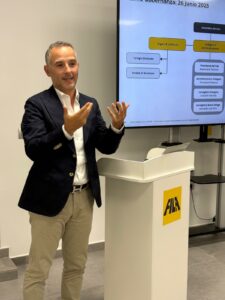
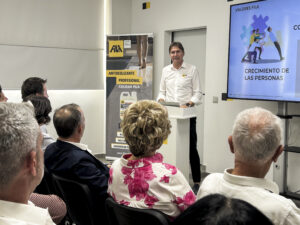
El nombramiento de un administrador único, con larga trayectoria dentro de la compañía, forma parte de una estrategia empresarial enfocada a mejorar el rendimiento y el crecimiento en un mercado cada vez más relevante. El Grupo, con un firme compromiso con la innovación, apuesta por líderes experimentados y de alto nivel dispuestos a guiar la expansión y desarrollo de la marca y afrontar los retos del futuro.
La continuidad está garantizada gracias a Paolo Gasparín y a Olga Redondo –nombrada apoderada especial. Ambos llevan vinculados a la filial desde sus inicios y seguirán desempeñando funciones clave. Su experiencia de más de una década y estrecho vínculo con la marca constituyen un pilar fundamental para el crecimiento y el mantenimiento de los valores que distinguen a FILA.
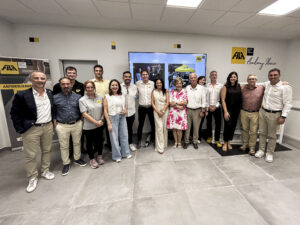
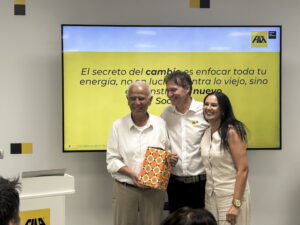
El cambio de denominación social refleja la evolución de FILA de fabricante de productos químicos a proveedor de soluciones integradas para la limpieza, protección y mantenimiento de superficies. Con este nuevo nombre, FILA SOLUTIONS IBERIA, S.L., subraya su capacidad para acompañar a profesionales y clientes en todas las fases del tratamiento, desde la limpieza a la protección, hasta el mantenimiento de todo tipo de superficies.
Esta nueva identidad encaja perfectamente con la reputación de FILA en el mercado español y portugués, gracias a colaboraciones y participaciones en proyectos de referencia. La empresa ha contribuido a la conservación y embellecimiento de obras icónicas, como el Balcón de Europa en Nerja, el Edificio Generali seguros en Madrid, o complejos de lujo como la piscina de 8.000 m² del Hotel Lopesan Costa Meloneras Resort & Spa en Gran Canaria.
La iniciativa PACK 2030 de Saint-Gobain, se enmarca en (RE)imagina, la hoja de ruta de Saint-Gobain hacia la neutralidad en carbono, se centra en la implementación de soluciones de embalaje sostenibles, que responden a las expectativas de los profesionales en términos de calidad y garantía, y a las demandas del mercado.
Saint-Gobain, líder mundial en construcción ligera y sostenible, reitera su compromiso con la sostenibilidad a través de la iniciativa PACK 2030 con la que pretende transformar el sistema de embalaje de la multinacional, alineándose con las mejores prácticas y estándares internacionales para reducir el impacto ambiental y promover la economía circular.
Debido a la cantidad de embalaje que se emplea, a su corta vida útil y a su único uso, este genera un impacto ambiental notable. Este impacto proviene de la extracción de materias primas, su transformación en embalaje, las diferentes etapas del transporte y la gestión de los residuos. En la actualidad, el mundo produce el doble de residuos plásticos que hace 20 años, y gran parte de ellos se depositan en vertederos, se incineran o se vierten al medio ambiente, de forma que, solo el 9% se recicla, según un informe publicado por la OCDE.
Atendiendo a esta situación, Saint-Gobain se ha fijado importantes objetivos para 2030 que afectan directa o indirectamente al embalaje y que incluyen: alcanzar el 100% de envases reutilizables o reciclables con al menos un 30% de contenido reciclado o de origen biológico, evitar en un 30% la utilización de materias primas vírgenes, y así reducir las emisiones de CO₂ contribuyendo a que se logre la neutralidad del carbono embebido para 2050.
Entre los avances más destacados del programa PACK 2030 en España, ya se emplea al menos un 30% de material reciclado en los films de embalaje para soluciones de ACH, Chryso, Distriplac, Isover, Leca, PAM, Placo®, Sekurit y Weber, alcanzando incluso el 80 % en algunos productos, como es el caso de Chryso e Isover. También se han introducido sacos sin film en algunas gamas de Weber y Placo®, como parte del compromiso por reducir el uso de materiales plásticos. Además, empresas como Norton, Sekurit Service y Weber ya utilizan cartón 100% reciclado. Entre otras iniciativas relevantes se encuentran la venta a granel o la implantación de sistemas de retorno y reutilización de palés en Adfors, Chryso, Incusa, Isover y Weber, así como una mejora continua en la segregación y gestión de residuos.
Estas acciones reflejan el compromiso real de Saint-Gobain con la economía circular y la reducción de la huella ambiental a lo largo de toda la cadena de valor.
PACK 2030 también promueve la creación de redes internas de sustainable packaging champions, que facilitan el intercambio de mejores prácticas e impulsan la innovación, así como comités de negocio a nivel país para integrar la sostenibilidad en todas las áreas de la compañía.
“Con PACK2030 queremos demostrar que la sostenibilidad en el embalaje no es solo una cuestión ambiental, sino también una oportunidad para transformar las cadenas de valor y generar un impacto positivo en las comunidades donde operamos. Este compromiso va más allá de nuestros productos, ya que buscamos inspirar a todo el sector y a nuestros clientes para que juntos redefinamos el estándar de responsabilidad en nuestra industria”, señala Mara Macarrón, responsable de Prescripción y Sostenibilidad de Saint-Gobain, sustainable packaging champion en España.
Por último, como parte de este proyecto, Saint-Gobain proporciona consejos y buenas prácticas para que otras compañías puedan replantearse qué tipo de sistema de embalaje emplean y cómo pueden mejorarlo en términos de sostenibilidad. De este modo, es una expresión concreta de (RE)imagina, la hoja de ruta que guía a Saint-Gobain hacia la neutralidad en carbono. Porque (RE)pensar cómo diseñamos, producimos y distribuimos es clave para construir un futuro más respetuoso con el planeta y con las personas. Esta iniciativa que fomenta la reutilización y el reciclaje de materiales de embalaje y promueve la economía circular, forma parte del propósito común del Grupo Saint-Gobain: “MAKING THE WORLD A BETTER HOME”.
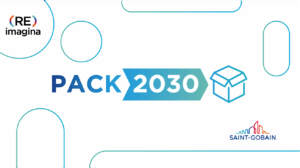
Sobre Saint-Gobain
Líder mundial en construcción ligera y sostenible, Saint-Gobain diseña, fabrica y distribuye materiales y servicios para los mercados de la construcción y la industria.
Sus soluciones completas orientadas a la renovación de edificios, la construcción ligera y la descarbonización de la industria, se desarrollan a través de un proceso continuo de innovación, proporcionando sostenibilidad y altas prestaciones. El Grupo, que celebra este año su 360 aniversario en el mundo y 120 años de presencia en España, está más comprometido que nunca con su propósito de “MAKING THE WORLD A BETTER HOME”.
Compañía Saint-Gobain a grandes cifras:
La iniciativa sensibiliza sobre los riesgos de la humedad y el moho en el hogar y ofrece soluciones prácticas para particulares y profesionales de la reforma.
Zehnder, referente en soluciones de climatización y ventilación saludable, presenta Expedición Reforma, una campaña que invita a repensar las reformas del hogar con un enfoque integral, donde el bienestar, la calidad del aire y la eficiencia energética son protagonistas. Bajo el lema ¿Reformas? ¡No lo hagas a medias!, la iniciativa pone el foco en un problema tan común como invisible: la humedad y el moho en viviendas mal ventiladas.
La humedad no solo deteriora el confort o la apariencia de un hogar. Puede provocar serias consecuencias para la salud, además de comprometer la durabilidad del inmueble. En España, cerca del 20 % de las viviendas presentan patologías relacionadas con la humedad —condensación, filtraciones o aislamiento deficiente— que aumentan el riesgo de aparición de moho, una de las principales causas de enfermedades respiratorias, especialmente en niños y personas mayores.
A esto se suma que, según estudios del sector, más del 70 % de las reformas se realizan por deterioro estructural o funcional, no por criterios de eficiencia o bienestar.
Expedición Reforma no se limita a concienciar, sino que ofrece recursos prácticos: herramientas, contenidos y asesoramiento técnico gratuito, tanto para usuarios finales como para arquitectos, instaladores y empresas de rehabilitación.
Entre los materiales disponibles se encuentran:
Las soluciones propuestas abarcan desde sistemas de ventilación mecánica con recuperación de calor hasta módulos climáticos integrados o equipos descentralizados para estancias concretas.
La campaña se articula con un enfoque doble. Por un lado, el usuario final puede acceder a recursos claros y fáciles para tomar decisiones más conscientes en sus reformas. Por otro, arquitectos, ingenieros e instaladores encontrarán soporte técnico, formación y asesoramiento personalizado para integrar soluciones Zehnder en cualquier tipo de proyecto.
Con esta iniciativa, Zehnder reafirma su compromiso con un modelo de reforma que no solo moderniza, sino que transforma los hogares en espacios más saludables, eficientes y confortables.
Más información en www.zehnder.es/es/proyectos-de-reforma
Zehnder Group es especialista en clima interior, bajo la marca Zehnder ofrece productos ecológicamente sostenibles para una ventilación con recuperación de calor confortable, saludable y eficiente. También desarrolla sistemas de climatización radiante y radiadores.
Las candidaturas podrán presentarse hasta el próximo 12 de septiembre, fecha en la que se cerrará el proceso de inscripción.
Saint-Gobain, en colaboración con el Club de Excelencia en Sostenibilidad, ha anunciado que amplía el plazo de presentación de candidaturas de la III Edición del Premio a la Mejor Práctica de Construcción Sostenible en España hasta el próximo 12 de septiembre. Esta iniciativa tiene como objetivo reconocer aquellos proyectos que promueven una edificación más eficiente, responsable y respetuosa con el medio ambiente, los recursos y materiales, el entorno y la sociedad.
Estos premios, de carácter nacional, suponen un importante reconocimiento, donde el jurado, compuesto por expertos de alto nivel en sostenibilidad, arquitectura, innovación y políticas públicas, garantiza la máxima calidad y rigor en la valoración de los proyectos.
Más allá del reconocimiento, los Premios Saint-Gobain visibilizan el compromiso con una edificación responsable y con propósito, permitiendo que las iniciativas participantes se posicionen como referentes en innovación y sostenibilidad dentro del sector. Los proyectos galardonados no solo contribuyen a mejorar la calidad de vida de las personas y del planeta, sino que pretenden inspirar y liderar el cambio hacia un modelo de construcción más sostenible e innovador.
Podrán presentarse candidaturas de proyectos que fomenten una edificación respetuosa y sostenible, en alguna de las siguientes cinco categorías:
1.- Proyecto de Administración Pública
2.- Proyecto de Promotora/Constructora
3.- Proyecto de Estudio de Arquitectura
4.- Proyecto de Startup
5.- Proyecto de Construcción Social
En la III Edición del Premio Saint-Gobain a la Mejor Práctica de Construcción Sostenible en España, se entregará un accésit al proyecto que demuestre mayor compromiso con la Economía Circular. Además, el evento de entrega de galardones reunirá a destacados actores de la edificación y ofrecerá un espacio de networking para fomentar el intercambio de ideas en torno a la sostenibilidad.
Más información sobre la III Edición del Premio Saint-Gobain a la Mejor Práctica de Construcción Sostenible en España aquí.
Sobre Saint-Gobain
Líder mundial en construcción ligera y sostenible, Saint-Gobain diseña, fabrica y distribuye materiales y servicios para los mercados de la construcción y la industria.
Sus soluciones completas orientadas a la renovación de edificios, la construcción ligera y la descarbonización de la industria, se desarrollan a través de un proceso continuo de innovación, proporcionando sostenibilidad y altas prestaciones. El Grupo, que celebra este año su 360 aniversario en el mundo y 120 años de presencia en España, está más comprometido que nunca con su propósito de “MAKING THE WORLD A BETTER HOME”.
Compañía Saint-Gobain a grandes cifras:
Saint-Gobain eleva su beneficio operativo hasta un récord de 2.803 millones de euros, un 5% más que en el mismo periodo de 2024, a tipo de cambio constante.
Saint-Gobain, líder mundial en construcción ligera y sostenible, ha anunciado los resultados financieros del primer semestre de 2025. El beneficio operativo del Grupo alcanzó los 2.803 millones de euros, lo que representa un aumento del 5% respecto al mismo periodo del año anterior a tipo de cambio constante (es decir, sin verse afectado por las variaciones del euro frente a otras monedas). Este resultado refleja el fuerte impulso de Asia-Pacífico y los países emergentes, la mejora progresiva en Europa y el sólido desempeño del negocio de soluciones de alto rendimiento (High Performance Solutions – HPS).
El flujo de caja libre se mantuvo robusto, con una conversión superior al 50%, apalancado en un EBITDA récord, que creció un 7% frente al primer semestre de 2024. Este sólido desempeño operativo se explica por una gestión disciplinada de precios, control de costes y eficiencia en la administración del capital circulante.
Las inversiones netas en adquisiciones estratégicas ascendieron a 1.700 millones de euros, muy por encima del mismo periodo del año anterior. Estas operaciones consolidan el liderazgo del Grupo en químicos para la construcción e incluyen la integración de Cemix (Latinoamérica), FOSROC (India y Oriente Medio), además de otras adquisiciones selectivas como Maturix, Interstar Materials, Soquimic e Isoltech.
Benoit Bazin, Presidente y Consejero Delegado de Saint-Gobain valoró los resultados:
“Los resultados del primer semestre de 2025 vuelven a demostrar la solidez del nuevo perfil de Saint-Gobain, con crecimiento en ventas y beneficios a pesar de la prudencia en algunos mercados. Asia y los países emergentes continuaron impulsando el crecimiento del Grupo, mientras que Europa mostró una mejora progresiva y Norteamérica registró un ligero descenso en ventas.
La integración de nuestras recientes adquisiciones ha reforzado la calidad de nuestro perfil de crecimiento rentable y nos permite beneficiarnos de una distribución equilibrada de resultados entre nuestras tres zonas geográficas.
Nuestro modelo operativo descentralizado por países, sin exposición directa a aranceles, es clave para resistir impactos externos. Nuestros directores generales en cada país gestionan ya toda nuestra oferta de soluciones, acelerando el crecimiento en todos los canales y segmentos de mercado.
Pese a un contexto macroeconómico todavía desigual y a la incertidumbre geopolítica, confío en que 2025 será otro año de éxito para Saint-Gobain, gracias al compromiso de nuestros equipos, a quienes felicito por su dedicación. En nuestro Capital Markets Day del 6 de octubre, presentaremos las nuevas ambiciones del Grupo como líder mundial en construcción ligera y sostenible, con foco en el crecimiento rentable, la creación de valor y el liderazgo en nuestros mercados”.
Desempeño por regiones
El negocio de Soluciones de Alto Rendimiento (HPS) registró un crecimiento orgánico del 0,8% y un margen operativo del 12,0%, a pesar de un entorno industrial más desafiante en Europa.
Saint-Gobain encara la segunda mitad del año con confianza en su capacidad para seguir superando a sus mercados, siempre que no se produzca una desaceleración significativa del crecimiento global debido a tensiones geopolíticas.
Desde el segundo semestre de 2025, Saint-Gobain reportará sus resultados bajo una nueva estructura regional que refleja mejor su estrategia local de crecimiento:
Sobre Saint-Gobain
Líder mundial en construcción ligera y sostenible, Saint-Gobain diseña, fabrica y distribuye materiales y servicios para los mercados de la construcción y la industria.
Sus soluciones completas orientadas a la renovación de edificios, la construcción ligera y la descarbonización de la industria, se desarrollan a través de un proceso continuo de innovación, proporcionando sostenibilidad y altas prestaciones. El Grupo, que celebra este año su 360 aniversario en el mundo y 120 años de presencia en España, está más comprometido que nunca con su propósito de “MAKING THE WORLD A BETTER HOME”.
Compañía Saint-Gobain a grandes cifras:
Anunciamos la próxima sesión de nuestras Masterclass XXL 2025, centrada en los procedimientos para la instalación de materiales de gran formato.
El encuentro técnico tendrá lugar el 18 de septiembre en Vitoria, en Jorge Fernández, y está dirigido a instaladores especializados, profesionales de la reforma integral, técnicos de obra y expertos en rehabilitación constructiva.
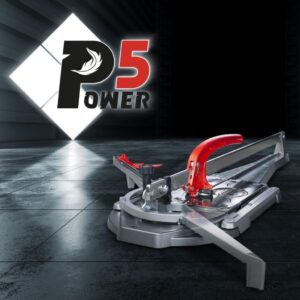 Sorteo exclusivo para asistentes a la Masterclass XXL 2025
Sorteo exclusivo para asistentes a la Masterclass XXL 2025Asistir a la Masterclass XXL no solo te permitirá descubrir las mejores técnicas y soluciones para la colocación cerámica, sino que también te dará la oportunidad de ganar una cortadora de cerámica Montolit Masterpiuma P5 de 131 cm.
Todos los asistentes a las Masterclass XXL 2025 entrarán automáticamente en el sorteo de esta herramienta profesional, reconocida por su precisión y rendimiento. Una razón más para no perderte esta experiencia única.
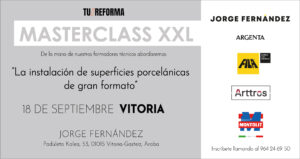
Será una oportunidad única para conocer las últimas tendencias en sostenibilidad y compartir conocimientos con otros expertos del sector. Los asistentes podrán acceder a una Masterclass especializada en superficies ultra compactas de grandes dimensiones, centrada en los formatos XXL.

Paduleta Kalea, 53, 01015
Vitoria-Gasteiz, Araba
Colaboradores:



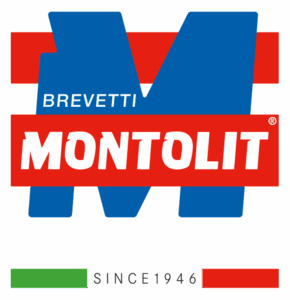
Con un diseño tubular muy actual y hasta seis acabados a elegir, la nueva columna de ducha de Gala, Tizona, está llamada a convertirse en el elemento diferenciador de las duchas más modernas.
Como firma líder en el equipamiento del baño y una trayectoria de 60 años en el sector, Gala sabe que los baños de hoy son espacios cada vez más exigentes tanto desde el punto de vista estético como funcional. Por eso, esta nueva columna favorece la personalización del espacio de ducha, al presentarse en seis acabados diferentes: cromado, negro, blanco mate, inox cepillado, oro cepillado y oro rosa cepillado. Sin duda, propuestas que siguen las más actuales tendencias del interiorismo y que permiten reforzar la continuidad estética en el baño, ya que la colección Tizona ofrece distintos modelos de grifería para lavabo, bidé y bañera en los mismos acabados.
Esta columna de ducha se compone de un rociador superior de gran caudal (20 cm de diámetro) con caída de agua tipo lluvia, para una experiencia más confortable, y ducha de mano con soporte y flexo de 175 cm. Además, la columna de ducha Tizona también está disponible con grifería termostática, que incorpora el dispositivo de seguridad 38º Safe Stop. Este sistema de seguridad evita que el agua supere, de manera involuntaria, los 38º grados de temperatura, algo realmente útil en hogares con niños, ya que se previenen posibles quemaduras.
Asimismo, la columna de ducha Tizona contribuye al menor consumo de agua gracias a que incluye un limitador de caudal de cinco litros por minuto, avalado por el programa europeo Water Label, que evalúa la eficiencia en el consumo de agua y energía de los productos. Esta colección de grifería contribuye, en este sentido, a la obtención de certificados de edificación sostenible.
Construcción sostenible y gestión responsable: un modelo pionero en Europa que reduce emisiones y logra el bienestar de los estudiantes.
Student Experience, operador internacional de residencias universitarias, ha logrado que su complejo de Madrid Pozuelo se convierta en la primera residencia universitaria en España en obtener la doble certificación BREEAM ES Excelente, tanto en la categoría de Edificio como en la de Gestión.
Este doble reconocimiento acredita que la residencia ha sido diseñada y construida bajo los más altos criterios de sostenibilidad y eficiencia energética, al tiempo que mantiene un modelo de gestión que prioriza el uso responsable de recursos, la reducción de emisiones y el bienestar integral de los estudiantes.
Las certificaciones BREEAM ES Excelente en Edificio y en Gestión validan el compromiso de Student Experience con un enfoque integral:
El resultado son espacios más saludables, con mejor calidad del aire, ahorro energético y un entorno que favorece el bienestar y la concentración de los estudiantes.
Innovación, sostenibilidad y servicios para estudiantes
El complejo de Pozuelo, con más de 19.000 m², incorpora tecnologías y soluciones pioneras como reciclaje de agua de lluvia, estaciones de carga de vehículos eléctricos, consigna digital, o la aplicación TULU, que permite alquilar en el propio edificio objetos tales como electrodomésticos pequeños (aspiradoras, planchas, secadores de pelo), herramientas de bricolaje (taladros, destornilladores, kits básicos), equipamientos deportivos y de ocio (pesas, colchonetas de yoga, raquetas, juegos de mesa) y accesorios de movilidad (cargadores de bicicleta eléctrica o cascos).
La idea es que los estudiantes puedan acceder de forma puntual a estos objetos, a través de una consigna inteligente en la propia residencia, reduciendo así el consumo innecesario y apostando por un estilo de vida más sostenible.
Las instalaciones están diseñadas para potenciar el bienestar físico, mental y social: piscina interior, gimnasio, pista de pádel en la azotea, biblioteca, coworking, salas de estudio, comedor saludable, huertos urbanos y jardines que promueven la vida comunitaria y la conexión con la naturaleza.
Compromiso ESG y expansión en España
Student Experience integra en su modelo los Objetivos de Desarrollo Sostenible (ODS) y el enfoque ESG (ambiental, social y de gobernanza), combinando criterios de eficiencia, multiculturalidad, inclusión y bienestar. “Queremos marcar un camino que inspire al sector a elevar sus estándares de sostenibilidad. Nuestras residencias son espacios para estudiar, vivir en comunidad y cuidar del planeta”, ha declarado Johan Verweij, fundador y CEO de la compañía.
Con más de 1.100 plazas ya disponibles en Madrid y Granada, la compañía ha diseñado un ambicioso plan de expansión en España para liderar este tipo de edificaciones sostenibles, en un principio, en la Comunidad de Madrid, consolidando la capital como hub internacional de alojamiento estudiantil. Este crecimiento se ampliará a nuevas localidades como Málaga.
Alianzas estratégicas
Student Experience trabaja junto a universidades como la Universidad Francisco de Vitoria, ESIC y la Universidad de Granada, y colabora con proveedores locales como DO EAT!, empresa pionera en restauración saludable y de proximidad. Además, impulsa talleres, actividades multiculturales y eventos de concienciación ambiental que fortalecen la experiencia comunitaria.
Sobre Student Experience
Student Experience es un concepto innovador, que ofrece un servicio completo de alojamiento sostenible a estudiantes de cualquier parte del mundo en Madrid, Granada, Ámsterdam, y Leiden. Un lugar construido para que el estudiante pueda concentrarse plenamente en sus estudios, mientras disfruta al máximo de la vida estudiantil en comunidad. Cuenta con instalaciones para hacer vida social, cuidar de la salud física, y desarrollar una cultura sostenible. Más información en https://studentexperience.com/es/
Este mes, centramos la mirada en un elemento clave de la arquitectura contemporánea: la cubierta.
Más allá de su función protectora, hoy se convierte en una superficie activa, estética y energética que define el carácter de cada proyecto.
En nuestro especial de cubiertas, exploramos cómo el diseño, la tecnología y la sostenibilidad se integran en soluciones que van desde sistemas fotovoltaicos de última generación hasta materiales que dialogan con el entorno y optimizan el rendimiento energético.
Además, nos adentramos en proyectos: Villa 95, de Fran Silvestre Arquitectos, una vivienda en la que la cubierta se convierte en una prolongación del paisaje, y Altos Reales, de Fuertes Santamarta, inspirada en un estilo natural, pero sofisticado y elegante.
Una edición que celebra la arquitectura inteligente, capaz de unir forma, función y energía en cada detalle.